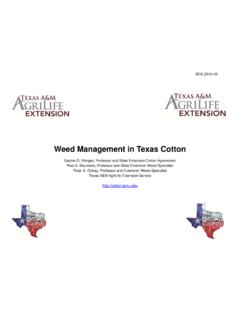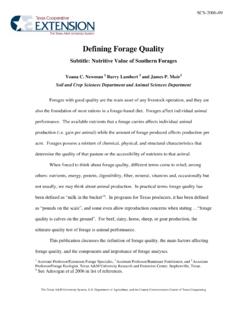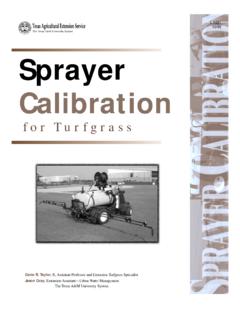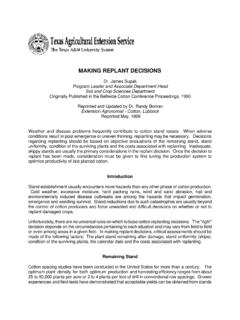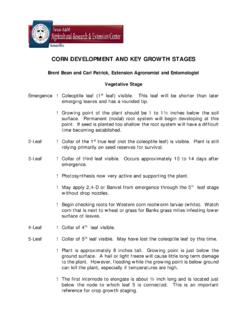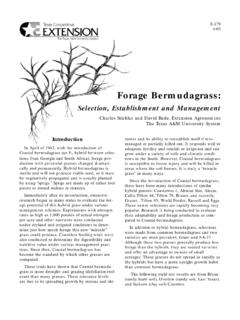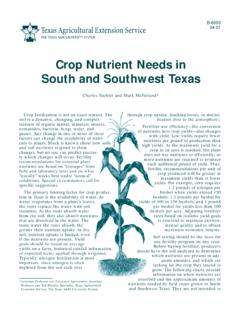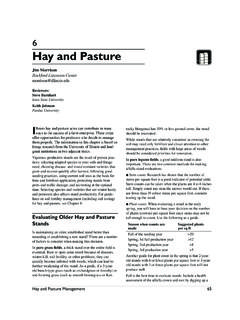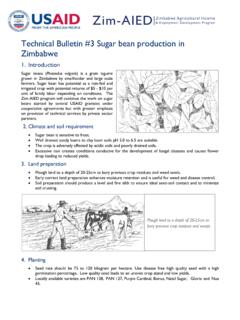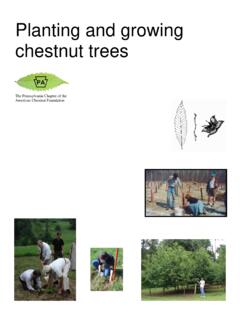Transcription of Sorghum Growth and Development - Texas A&M University
1 Sorghum Growth and Development Thomas Gerik, Brent Bean and Richard Vanderlip*rounded leaf tip. The leaf collar marks the junctionof the leaf blade and sheath and appears when theleaf is fully developed. Each leaf sheath originatesat its own node on the plant stalk. The sheath sur-rounds and strengthens the stalk (culm). The flagleaf is the last to emerge on the plant and is con-siderably smaller than the other leaves. The panicle(head) emerges from the flag leaf sheath and is sup-ported by the portion of the stalk called the pedun-cle. From Planting to EmergenceThe time from planting to emergence (usually 5to 10 days) depends on the growing conditions soil temperature and moisture; the depth of plant-ing and, to some extent, seed vigor . Slow emergenceoften results in uneven, skimpy plant stands anddecreased yield.
2 Before emergence, the plant istotally dependent on food reserves in the seed fromthe endosperm for survival. Slow emerging plantsrisk depleting these reserves, which are importantto early plant Growth in the days immediately fol-lowing emergence. Some of the factors thatadversely affect emergence and early plant growthare: Cool, Wet prefer warm, moistsoil for germination and emergence. Cool, wetsoils promote the Development of ideal temperature for Sorghum germina-IS ALL we sell in agriculture. Whetherthe enterprise is corn, cattle, cauliflower,cotton, or grain Sorghum water is essen-tial for its production and the Rto Texas , and its ability to yield consistently inharsh environments makes it popular with a perennial plant by nature, grainsorghum is customarily grown as an annual how the Sorghum plant develops is impor-tant in understanding how to manage the Key PlantStructuresUnderstanding crop Growth and developmentbegins with knowing its structures and plant structures are shown in Figure 1.
3 Thefirst leaf visible at emergence is the coleoptile differs from all of the other leaves in that it has a*Professor, Texas Agricultural Experiment Station,Temple, TX; Professor and Extension Agronomist, TexasCooperative Extension, Amarillo, TX, The Texas A&MUniversity System and Professor, Kansas State Univer-sity, Manhattan, KSB-61377-03 ORGHUM IS WELL-ADAPTEDSATER tion and emergence is 70 degrees F. Althoughgermination can occur at temperatures below50 degrees F, emergence is delayed. For opti-mum germination and emergence, delayplanting until the 5-day average daily soiltemperature at the two-inch depth reaches 60degrees F. In central and south Texas , pre-dominantly dark color soils and higher fre-quency of warm spring temperatures allowgrowers to begin planting when soil tempera-tures are 50-55 degrees F.
4 If planting in cool,wet soils cannot be avoided, plant shallow anduse fungicide seed treatments. crusts, typically to thick, hinder a plant s ability toemerge. Crusts typically form after hard rainand when weather warm temperature, lowhumidity and high winds promotes veryrapid soil drying. Soils with high content offine sand and silt more readily form cruststhan coarse sand and clay textured soils. Lighttillage with a rotary harrow or sprinkler irri-gation can sufficiently weaken crusts to allowthe plants to emerge. Cropping systems thatleave large amounts of plant residue on thesoil surface, such as no- till or conservationtillage, help reduce soil crusting. Herbicide chloroac-etamide herbicides ( Dual, Lasso, Frontier)are widely used to control weeds in , they can significantly injure thecrop if rainfall moves the herbicide to a depthwhere it can be absorbed by the roots andshoots as they emerge from the seed .
5 In severecases, the plants may not emerge from the soilbut will try to leaf out under the soil emerged, the leaves may not unfurlproperly and appear twisted, with the leaf tipsbeing trapped in the whorl. In addition, plantsmay be stunted with purple leaf sheaths andleaf margins. Sorghum can recover from thisinjury if good growing conditions quicklyreturn. Injury is accentuated in cool or crust-ed soils, since the plant emerges slowly andabsorbs more herbicide. seed treated withherbicide seed safeners ( Concept) must beused if these herbicides are to be applied butdo not guarantee the crop will completelyescape injury when adverse weather or plant-ing conditions are StagesOnce grain Sorghum emerges, the plant developsin a predictable manner characterized by three dis-tinct Growth stages GS I, GS II and GS III.
6 Amedium-maturity hybrid requires approximately 32to 35 days to pass through each stage, depending onthe hybrid and environmental conditions. Modernhybrids are insensitive to day length, meaning theirrate of Development is primarily driven by Stage IThis first Growth stage, GS I, is characterized byvegetative Growth . The plant develops its vegetativestructures, leaves and tillers, which ultimately sup-port grain formation and Growth . Because modernhybrids are insensitive to day length, the durationof GS I largely depends on air temperature and thenumber of leaves genetically predisposed to formon the hybrid s main stalk. The more leaves formedby the hybrid, the longer maturity ( , more timeis required from planting to harvest) and greater itspotential to produce forage and grain. Early-matur-ing hybrids typically produce 15 leaves per plant,while medium- and late-maturing hybrids produce17 and 19 leaves each.
7 2headpeduncleflag leafflag leafsheathleaf bladeleaf collar2nd leaf3rd leafleaf sheath1st leafSeedFigure 1. Typical grain Sorghum plants at physiological maturity(left) an a 3-leaf Growth stage (right).Stages within GS I are characterized by the num-ber of leaves with visible collars. The smaller of thetwo plants in Figure 1 is at the 3-leaf stage becausethe collars of the first, second and third leaves arevisible. In this example, all or portions of six leavescan be observed, but because only three collars arevisible, it is considered to be in the 3-leaf stage. Sorghum can tolerate high degrees of stress fromdrought, hail and freezing temperatures in GS Iwith little adverse affect on yield. But insect pests,if untreated, can irreparably harm the crop. Abnor-mally dry and/or cool weather promotes the devel-opment of damaging pests such as corn leaf aphids,greenbugs and chinch bugs.
8 Most post-emergentherbicides are applied during GS I. Follow labeldirections carefully to prevent crop cool, cloudy weather in GS I may alsocause a purple coloring on leaf sheaths and blademargins, and the blades can develop an interveinalyellow striping (chlorosis). The purple color occursfrom the accumulation of anthocyanin in the tissueand results from insufficient phosphorous uptakeor from the plant s inability to move sugars fromthe leaf blade. Leaf striping is often caused frominsufficient iron or zinc uptake. Symptoms usuallydisappear when favorable temperatures and zinc deficiencies will be more pronouncedin high calcareous , sunny days with temperatures below 65degrees F favor tiller appearance on basal nodes(nodes at the base of the plant) of plants at the four-and six-leaf stage. Plant densities of fewer thanthree plants per row-foot promote tillering, whilemore than four plants per foot suppresses of tillers are smaller and flower later thanthose on the main stalk.
9 Basal tillers formed at thisstage can compensate somewhat for losses in plantemergence. Some hybrids have a tendency to tillermore than Stage IIThe second Growth stage, GS II, is the periodwhen reproductive structures of the panicle formand the maximum number of seed per plant are is considered the most critical period for grainproduction, because seed number per plantaccounts for 70 percent of Sorghum s final grainyield. Anything that impedes panicle developmentduring this period reduces the number of seed to beformed, which lowers grain II begins with panicle initiation and con-tinues to flowering. The initiation of the panicle ismarked by the appearance of protrusions (seen asraised bumps) on the surface of the plant s growingpoint about 30 to 35 days after emergence (Figure2). These are the primordial structures that ulti-mately form the panicle branches, which later dif-ferentiate into spikelet branches and floral struc-tures responsible for seed set and grain are easily identified with the naked eye byvertically splitting the stalk with a sharp knife andlocating the growing point when 7 to 10 leaves havefully developed ( , note one to three leaves mayhave been lost, since the lower leaves die and falloff as the plant grows, making correct identificationof the leaf stage more difficult).
10 Use the coleoptileleaf (small, round tipped) as leaf number one. If itis not present, use the number of nodes at the baseof the plant to determine the correct leaf stage. Thefirst internode (lowest on the plant) that can beobserved is internode four. This will be approxi-mately one-fourth inch long. An internode is theportion of the stalk between nodes. Subsequentinternodes will be progressively longer if goodgrowing conditions exist. The leaf sheath of leaffive originates from node five. All other leaves caneasily be identified using leaf five as a Sorghum is being grown under irrigation, it isimportant that the crop not be allowed to stress atthe beginning of this stage when the potentialnumber of seed per plant is being set. Followingpanicle initiation, the plant abruptly stops formingnew leaves and begins to form the plant s repro-ductive structures.

